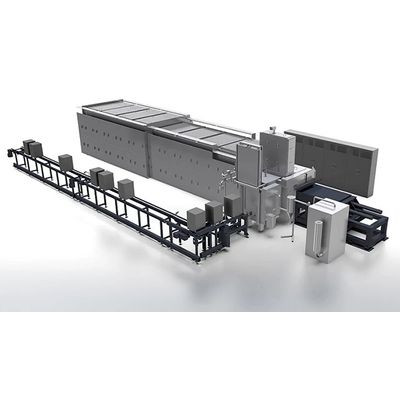

- Home
- Companies
- ONEJOON GmbH
- Products
- ONEJOON - Pusher Slab Kilns

ONEJOON - Pusher Slab Kilns
The Pusher Slab Kiln from ONEJOON is the ideal solution for processes with high production capacity and strict requirements when it comes to temperature homogeneity. In addition, our Pusher Slab Kilns offer extensive control of the relevant process parameters. With a Pusher Slab Kiln, it is possible to scale up the technically demanding processes developed in a small scale without having to accept compromises in process precision (such as temperature control or comparative moderation). The modern ONEJOON Pusher Slab Kiln is energy-efficient and requires little production space. This significantly reduces not only the investments required, but also the operating costs.
For processes with high demands on gas feed and gas flow control, such as debinding or calcination, the Pusher Slab Kiln offers a modern system for gas preheating and controlled gas flow. Depending on atmospheric conditions and process temperatures, the Pusher Slab Kilns can be heated either electrically or with gas. Application temperatures of up to 2000 °C can be achieved. Both direct and indirect cooling or even active gas cooling with or without chemical influence on the product are possible. ONEJOON`s high performance Pusher Slab Kilns have been developed on the basis of numerous simulation studies and experimental validations in close cooperation with end users.
With ONEJOON pusher plate kilns different processes can be mapped.
These include, for example:
- calcination
- debinding
- sintering
- carbonization
- brazing
- pyrolysis
- quick cooling
- special processes
- and many more
The furnace load is conveyed through the furnace by a hydraulic pusher or by an electric pusher with a spindle drive. For this purpose, the load is first stacked on a pusher plate and then positioned in front of the respective pusher head. Up to 15 tons of material can be pushed in a single push row. The high pushing forces are absorbed by a suitable design of the bricks in the kilns base. Thus there is no risk of accidents due to high friction. If the process is to take place in a certain atmosphere, loading is carried out through an enterance airlock into the furnace, where an atmosphere exchange takes place. In this case, the positioning of the load is also done within the airlock and the push head is guided through the airlock wall with the help of special seals.
In the heating area, the load is heated by means of heating elements or gas burners according to the required temperature profile. The type, design and dimensions of the heaters or burners can vary depending on the application. It is possible to feed dosed preheated process gas through locally installed nozzles.
The furnace is designed in segmental construction so that the process steps of heating, holding and cooling can be shortened or lengthened as required. Between each furnace segment there are separating baffles which minimize thermal and atmospheric influence from the adjacent segments. Each segment can be connected to the higher-level supply or exhaust gas system by its own injection and extraction pipes.
After heating, the load can be cooled directly or indirectly. With direct cooling, it is possible to reuse a large part of the cooling medium in a closed circuit. After cooling, the load is conveyed outside, either through an exit airlock or through a normal furnace door.
- excellent temperature homogeneity
- very high throughput
- excellent gas flow
- process gas preheating up to 800 °C
- low space requirement, compact layout
- designed in modular construction
- maximum energy efficiency
- high temperature sintering up to 1,800 °C
- high gas tightness
- enterance and exit airlocks up to 600 °C
- gas preheating systems
- gas or electric heating
- heat treatment of very heavy loads possible
- modern and flexible cooling
- enormous savings in production costs and space
- CFD simulation to optimise the air flow
